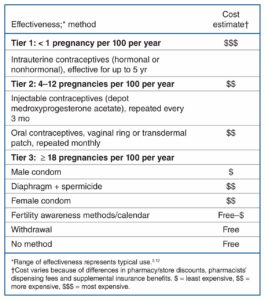For young, sexually active Canadians, safe and reliable contraceptives are critical to avoiding unintended pregnancies. But the most effective methods of birth control are also the most expensive, and a new study shows that low-income Canadians aren’t using them because their cost puts them out of reach.
Researchers from the University of British Columbia have recently linked lower household incomes to decreased use of oral contraceptives, and increased reliance on less-effective birth control methods such as condoms or withdrawal. This suggests that while Canada does provide access to a range of contraceptive methods, financial barriers mean that not all methods are equally accessible.
“[A]ccess to contraceptives is something that benefits public health by allowing people to plan pregnancies,” said Elizabeth Nethery, lead author of the study and a PhD student in UBC’s School of Population and Public Health, in a press release. “But our research shows that there may be cost barriers that could be potentially improved when it comes to contraceptive care in Canada.”
The study was published in CMAJ Open, and made use of data collected for the 2009-2010 and 2013-2014 Canadian Community Health Surveys carried out by Statistics Canada.
The subset of the survey respondents Nethery used in her analysis included Canadians aged 15-24 who were determined to be at risk for unintended pregnancy: those who indicated in their responses that they had the potential to become pregnant, and agreed with the statement “It is important to me to avoid getting pregnant right now.”
Survey respondents could choose one or more birth control options out of oral contraceptives (i.e. the pill), injectable contraceptives, condoms, diaphragms, spermicide, or other. While oral contraceptives are more effective than other methods (such as condoms, for example), they also come at a much higher cost.

When comparing contraceptive use between different income brackets, Nethery and her colleagues found that Canadians with lower household incomes (less than $80,000 per year) were 15% less likely to use oral contraceptives and 19% less likely to use dual methods (condoms plus oral contraceptives, for example).
While the higher cost of oral contraceptives compared to condoms may be one explanation for these results, the authors also suggest that Canadians from higher-income households are more likely to have access to prescription drug benefits that can offset the costs of birth control.
Today, Canada is one of the only countries with universal health care that does not also provide universal access to contraception. And while organizations like Planned Parenthood do offer a range of birth control options at reduced costs, Nethery’s study illustrates that there is still a need for increased access to affordable birth control nationwide.
The Canadian Paediatric Society (CPS) recently made a similar recommendation. To reduce barriers to effective birth control and decrease rates of unplanned pregnancies, CPS is calling for all Canadian youth under the age of 25 to have confidential access to contraception at no cost.
By offering increased access to the most effective contraceptives, Canada will save on health care costs associated with unintended pregnancies, and Canadians themselves will be safer and healthier as a result.








































